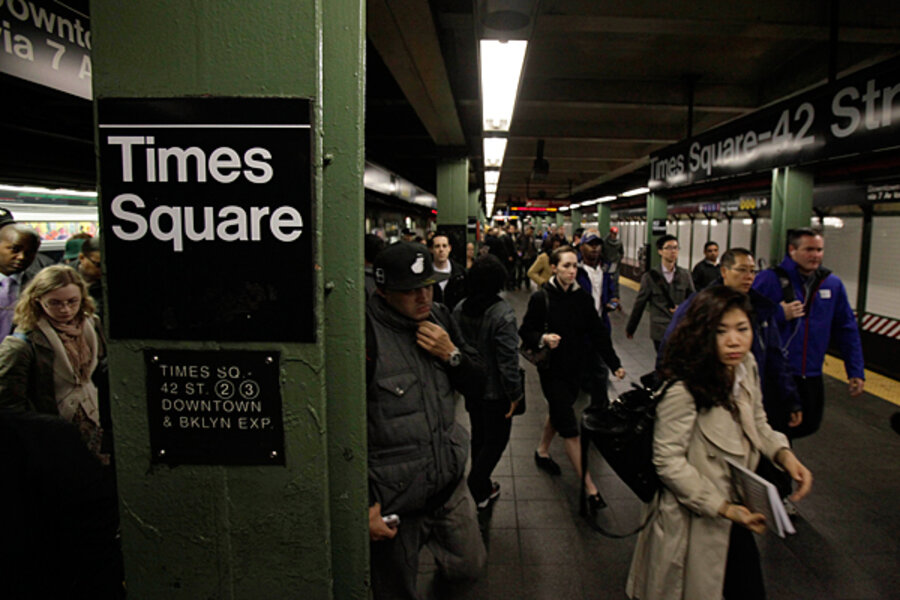New York subways roll, but road to recovery will be long ... and costly
Loading...
| New York
Along with restoring electrical power, getting the nation’s largest subway system back up and running at full speed is crucial to New York City’s recovery from superstorm Sandy. But it is likely to be a long, complicated, and very expensive task.
Yes, some of New York’s subways did start to roll Thursday morning, and strap hangers got free rides.
But it was only partial service. Below 34th Street the system had no power.
Major segments of the subway system’s 830 miles of track were still inundated Thursday with water that Sandy’s storm surge had pushed into the tunnels. Electrical equipment, such as signals that tell subway operators what speed to travel, not to mention the third rail that carries high voltage electricity to the cars, are submerged in corrosive salt water.
That means that New York, a major center of commerce, was still operating at well below its normal speed, with many workers still unable to get to their jobs. Everyone from Mayor Michael Bloomberg to the janitors who keep buildings clean use the trains.
“The subway is the lifeblood of New York,” says Michael Mulhern, the executive director of the Massachusetts Bay Transportation Authority Retirement Fund and the former general manager of the MBTA.
At a press briefing on Wednesday, Mayor Bloomberg said he would be surprised if the subways that run under the East River would be back and running by the weekend.
“If they could do that I think that would be amazing,” Bloomberg said. “It may stretch a little longer.”
According to subway experts, it may be even more difficult and time-consuming than Bloomberg realizes.
For example, in 1996, the Muddy River, a tiny tributary of the Charles River in Boston, overflowed its banks after 9 to 10 inches of rain in 24 hours.
Mr. Mulhern was then the director of subway operations at the MBTA when the flood took place. About six stations on Boston’s Green Line, a light rail operation, filled with water. While some service was restored within a week, it was a full year, he says, before the system was back at full capacity.
“That was fresh water,” recalls Mulhern in an interview. “Salt water worsens the situation.”
To get the New York subways up and running, the salt water will have to be pumped out, which is happening. Debris will have to be removed. Then, Mulhern says, the system will have to be power washed with fresh water.
“Then you have to step back and ask what has been damaged and must be replaced,” he says. “It is likely that a lot of the subsystems need to be replaced.”
In addition to replacing the vital system of signals that subway drivers rely on, some stations may require new escalators or elevators to help the disabled negotiate the system. Turnstiles and fare-dispensing machines may need to be replaced.
“Some of these things are not items you buy off the shelf,” he says.
The Metropolitan Transit Authority (MTA) is likely to have some items in its inventory, says transit expert Kathryn Waters, a vice president at the American Public Transit Association, a lobbying group in Washington.
However, Ms. Waters, who was second in command at the Maryland Transit Administration in Baltimore, says she found that the manufacturers of some of the equipment Maryland used had gone out of business. “Sometimes you can use a substitute, sometimes you have custom work done,” she says.
Waters says other transit systems may be able to help New York, if necessary. “If New York does not have spare parts maybe someone else does,” she says. “We could coordinate that for them.”
All that takes time.
Mulhern says Boston got some subway service running in a week. However, he says the MBTA had to scale back the number of trains it could run at any given time. With signals damaged it had to space trains further apart. The trains also ran slower.
“When it was finally up and running it was initially far less service than commuters were used to,” says Mulhern. “It took us a year to get back to full capacity. I think it will be a long time before New York’s services are back to normal.”
Not only is it time-consuming to rebuild the transit system, it is expensive. Back in 1996, Mulhern says it cost $70 million (about $81 million in today’s dollars.)
For New York he expects it will cost billions of dollars.
“Most of the funds will come from FEMA,” he says, referring to the Federal Emergency Management Agency, which provides aid in times of emergencies. It is likely Congress will have to authorize the funding.
“I know the president has talked about cutting through all the red tape,” he says. “But, one of the things we did was to hire an engineering firm on day one to track all our expenditures – it built credibility with the federal government.”
On Thursday, Homeland Security Secretary Janet Napolitano got a tour of the damage to the city and the subways.
Gov. Andrew Cuomo hit her up for money right away. “We would like FEMA to reimburse us at 100 percent,” he said at a press conference. “The burden is too much for New York to carry.”
Normally, FEMA reimburses at the rate of 75 percent of the cost of a disaster. But, at the same press conference, Sen. Chuck Schumer said FEMA, which is part of DHS, had told him it was going to reimburse New York at the rate of 100 percent of emergency transportation funds as well as cover the cost of restoring power.





